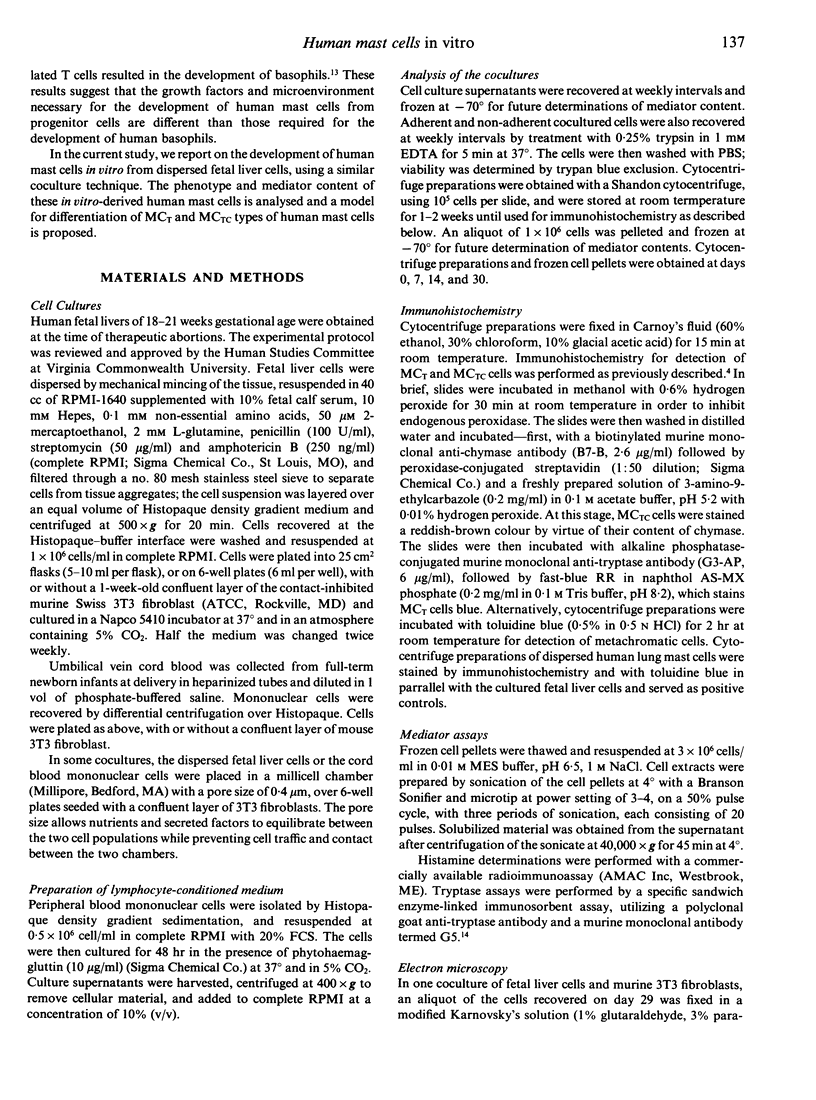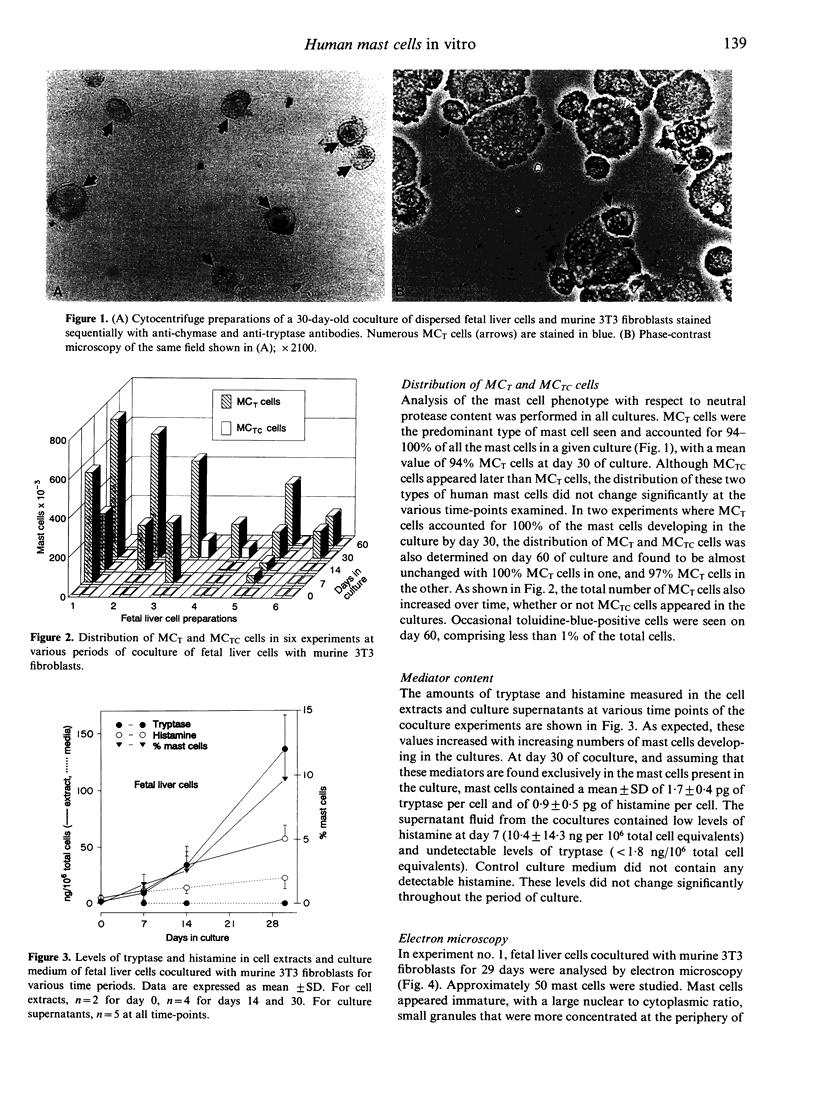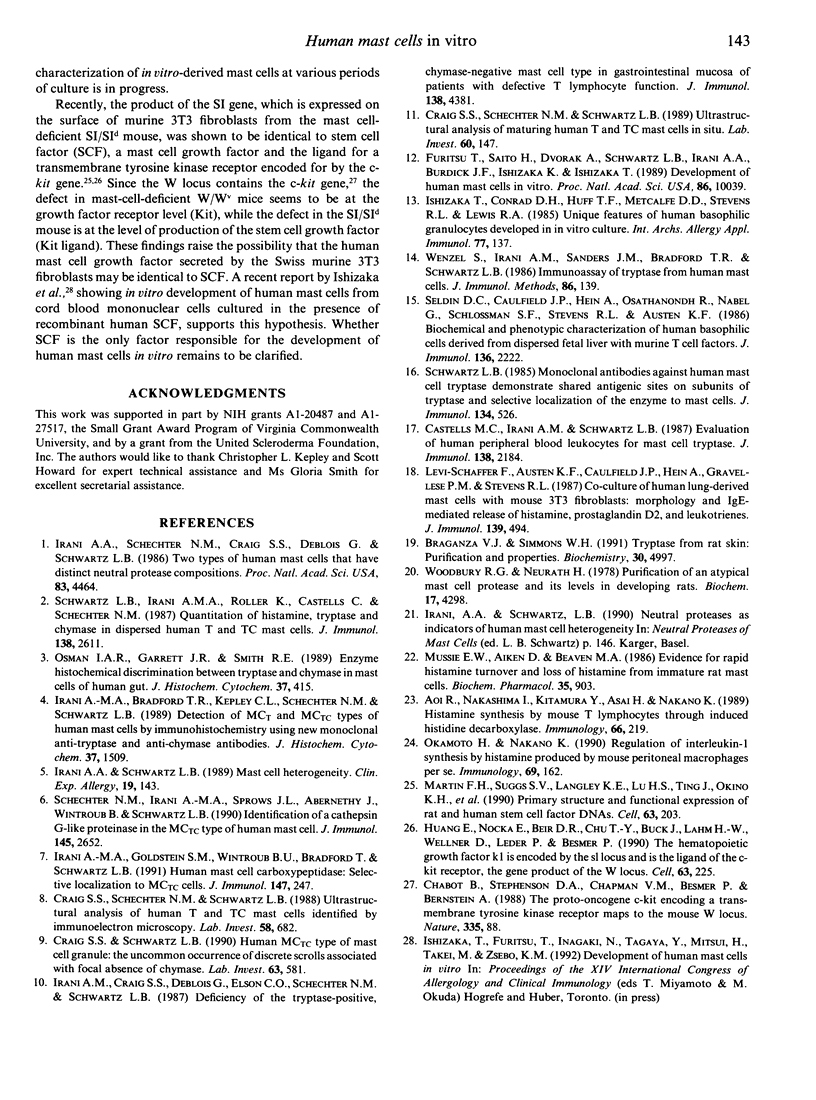Abstract
Cocultures of dispersed human fetal liver cells with murine Swiss 3T3 fibroblasts resulted in the development of human mast cells after 1 to 4 weeks of culture. Mast cells were detected by immunohistochemistry using a murine monoclonal anti-tryptase antibody, before metachromasia appeared with toluidine blue. When subjected to double immunohistochemistry using murine monoclonal anti-chymase and anti-tryptase antibodies, 94% +/- 10% (SD) of the mast cells seen at day 30 of culture were of the MCT type. These results contrast with those obtained with human mast cells derived from cord blood mononuclear cells cocultured with murine 3T3 fibroblasts which are comprised of substantially greater numbers of MCTC cells, averaging 48% +/- 31% (SD) at day 30 of culture. Mast cells developed in vitro from fetal liver cells or cord blood mononuclear cells contained similar amounts (+/- SD) of histamine (0.9 +/- 0.5 pg/cell and 1.1 +/- 1 pg/cell, respectively) and tryptase (1.7 +/- 0.4 pg/cell and 1.9 +/- 1.2 pg/cell, respectively) on day 30 of culture. Fetal-liver-derived mast cells from a 30-day-old culture were identified by immunoelectron microscopy using gold-labelled antitryptase antibody. Typically, these mast cells appeared immature as they had large nuclear to cytoplasmic ratio and a small number of ill-formed cytoplasmic granules. For both fetal-liver- and cord-blood-derived mast cells, there was no evidence of conversion of the MCT type into the MCTC type provided by this study. These results suggest that commitment to develop as an MCT or MCTC type of mast cell may have occurred in mast cell precursors present in fetal liver and cord blood mononuclear cells, prior to granulation.
Full text
PDF







Images in this article
Selected References
These references are in PubMed. This may not be the complete list of references from this article.
- Aoi R., Nakashima I., Kitamura Y., Asai H., Nakano K. Histamine synthesis by mouse T lymphocytes through induced histidine decarboxylase. Immunology. 1989 Feb;66(2):219–223. [PMC free article] [PubMed] [Google Scholar]
- Braganza V. J., Simmons W. H. Tryptase from rat skin: purification and properties. Biochemistry. 1991 May 21;30(20):4997–5007. doi: 10.1021/bi00234a023. [DOI] [PubMed] [Google Scholar]
- Castells M. C., Irani A. M., Schwartz L. B. Evaluation of human peripheral blood leukocytes for mast cell tryptase. J Immunol. 1987 Apr 1;138(7):2184–2189. [PubMed] [Google Scholar]
- Chabot B., Stephenson D. A., Chapman V. M., Besmer P., Bernstein A. The proto-oncogene c-kit encoding a transmembrane tyrosine kinase receptor maps to the mouse W locus. Nature. 1988 Sep 1;335(6185):88–89. doi: 10.1038/335088a0. [DOI] [PubMed] [Google Scholar]
- Craig S. S., Schechter N. M., Schwartz L. B. Ultrastructural analysis of human T and TC mast cells identified by immunoelectron microscopy. Lab Invest. 1988 Jun;58(6):682–691. [PubMed] [Google Scholar]
- Craig S. S., Schechter N. M., Schwartz L. B. Ultrastructural analysis of maturing human T and TC mast cells in situ. Lab Invest. 1989 Jan;60(1):147–157. [PubMed] [Google Scholar]
- Craig S. S., Schwartz L. B. Human MCTC type of mast cell granule: the uncommon occurrence of discrete scrolls associated with focal absence of chymase. Lab Invest. 1990 Oct;63(4):581–585. [PubMed] [Google Scholar]
- Furitsu T., Saito H., Dvorak A. M., Schwartz L. B., Irani A. M., Burdick J. F., Ishizaka K., Ishizaka T. Development of human mast cells in vitro. Proc Natl Acad Sci U S A. 1989 Dec;86(24):10039–10043. doi: 10.1073/pnas.86.24.10039. [DOI] [PMC free article] [PubMed] [Google Scholar]
- Huang E., Nocka K., Beier D. R., Chu T. Y., Buck J., Lahm H. W., Wellner D., Leder P., Besmer P. The hematopoietic growth factor KL is encoded by the Sl locus and is the ligand of the c-kit receptor, the gene product of the W locus. Cell. 1990 Oct 5;63(1):225–233. doi: 10.1016/0092-8674(90)90303-v. [DOI] [PubMed] [Google Scholar]
- Irani A. A., Schechter N. M., Craig S. S., DeBlois G., Schwartz L. B. Two types of human mast cells that have distinct neutral protease compositions. Proc Natl Acad Sci U S A. 1986 Jun;83(12):4464–4468. doi: 10.1073/pnas.83.12.4464. [DOI] [PMC free article] [PubMed] [Google Scholar]
- Irani A. M., Bradford T. R., Kepley C. L., Schechter N. M., Schwartz L. B. Detection of MCT and MCTC types of human mast cells by immunohistochemistry using new monoclonal anti-tryptase and anti-chymase antibodies. J Histochem Cytochem. 1989 Oct;37(10):1509–1515. doi: 10.1177/37.10.2674273. [DOI] [PubMed] [Google Scholar]
- Irani A. M., Craig S. S., DeBlois G., Elson C. O., Schechter N. M., Schwartz L. B. Deficiency of the tryptase-positive, chymase-negative mast cell type in gastrointestinal mucosa of patients with defective T lymphocyte function. J Immunol. 1987 Jun 15;138(12):4381–4386. [PubMed] [Google Scholar]
- Irani A. M., Goldstein S. M., Wintroub B. U., Bradford T., Schwartz L. B. Human mast cell carboxypeptidase. Selective localization to MCTC cells. J Immunol. 1991 Jul 1;147(1):247–253. [PubMed] [Google Scholar]
- Irani A. M., Schwartz L. B. Mast cell heterogeneity. Clin Exp Allergy. 1989 Mar;19(2):143–155. doi: 10.1111/j.1365-2222.1989.tb02357.x. [DOI] [PubMed] [Google Scholar]
- Irani A. M., Schwartz L. B. Neutral proteases as indicators of human mast cell heterogeneity. Monogr Allergy. 1990;27:146–162. [PubMed] [Google Scholar]
- Ishizaka T., Conrad D. H., Huff T. F., Metcalfe D. D., Stevens R. L., Lewis R. A. Unique features of human basophilic granulocytes developed in in vitro culture. Int Arch Allergy Appl Immunol. 1985;77(1-2):137–143. doi: 10.1159/000233768. [DOI] [PubMed] [Google Scholar]
- Levi-Schaffer F., Austen K. F., Caulfield J. P., Hein A., Gravallese P. M., Stevens R. L. Co-culture of human lung-derived mast cells with mouse 3T3 fibroblasts: morphology and IgE-mediated release of histamine, prostaglandin D2, and leukotrienes. J Immunol. 1987 Jul 15;139(2):494–500. [PubMed] [Google Scholar]
- Martin F. H., Suggs S. V., Langley K. E., Lu H. S., Ting J., Okino K. H., Morris C. F., McNiece I. K., Jacobsen F. W., Mendiaz E. A. Primary structure and functional expression of rat and human stem cell factor DNAs. Cell. 1990 Oct 5;63(1):203–211. doi: 10.1016/0092-8674(90)90301-t. [DOI] [PubMed] [Google Scholar]
- Okamoto H., Nakano K. Regulation of interleukin-1 synthesis by histamine produced by mouse peritoneal macrophages per se. Immunology. 1990 Jan;69(1):162–165. [PMC free article] [PubMed] [Google Scholar]
- Osman I. A., Garrett J. R., Smith R. E. Enzyme histochemical discrimination between tryptase and chymase in mast cells of human gut. J Histochem Cytochem. 1989 Apr;37(4):415–421. doi: 10.1177/37.4.2647838. [DOI] [PubMed] [Google Scholar]
- Schechter N. M., Irani A. M., Sprows J. L., Abernethy J., Wintroub B., Schwartz L. B. Identification of a cathepsin G-like proteinase in the MCTC type of human mast cell. J Immunol. 1990 Oct 15;145(8):2652–2661. [PubMed] [Google Scholar]
- Schwartz L. B., Irani A. M., Roller K., Castells M. C., Schechter N. M. Quantitation of histamine, tryptase, and chymase in dispersed human T and TC mast cells. J Immunol. 1987 Apr 15;138(8):2611–2615. [PubMed] [Google Scholar]
- Schwartz L. B. Monoclonal antibodies against human mast cell tryptase demonstrate shared antigenic sites on subunits of tryptase and selective localization of the enzyme to mast cells. J Immunol. 1985 Jan;134(1):526–531. [PubMed] [Google Scholar]
- Seldin D. C., Caulfield J. P., Hein A., Osathanondh R., Nabel G., Schlossman S. F., Stevens R. L., Austen K. F. Biochemical and phenotypic characterization of human basophilic cells derived from dispersed fetal liver with murine T cell factors. J Immunol. 1986 Mar 15;136(6):2222–2230. [PubMed] [Google Scholar]
- Wenzel S., Irani A. M., Sanders J. M., Bradford T. R., Schwartz L. B. Immunoassay of tryptase from human mast cells. J Immunol Methods. 1986 Jan 22;86(1):139–142. doi: 10.1016/0022-1759(86)90277-2. [DOI] [PubMed] [Google Scholar]
- WoldeMussie E., Aiken D., Beaven M. A. Evidence for rapid histamine turnover and loss of histamine from immature rat mast cells. Biochem Pharmacol. 1986 Mar 15;35(6):903–909. doi: 10.1016/0006-2952(86)90075-4. [DOI] [PubMed] [Google Scholar]
- Woodbury R. G., Neurath H. Purification of an atypical mast cell protease and its levels in developing rats. Biochemistry. 1978 Oct 3;17(20):4298–4304. doi: 10.1021/bi00613a029. [DOI] [PubMed] [Google Scholar]




